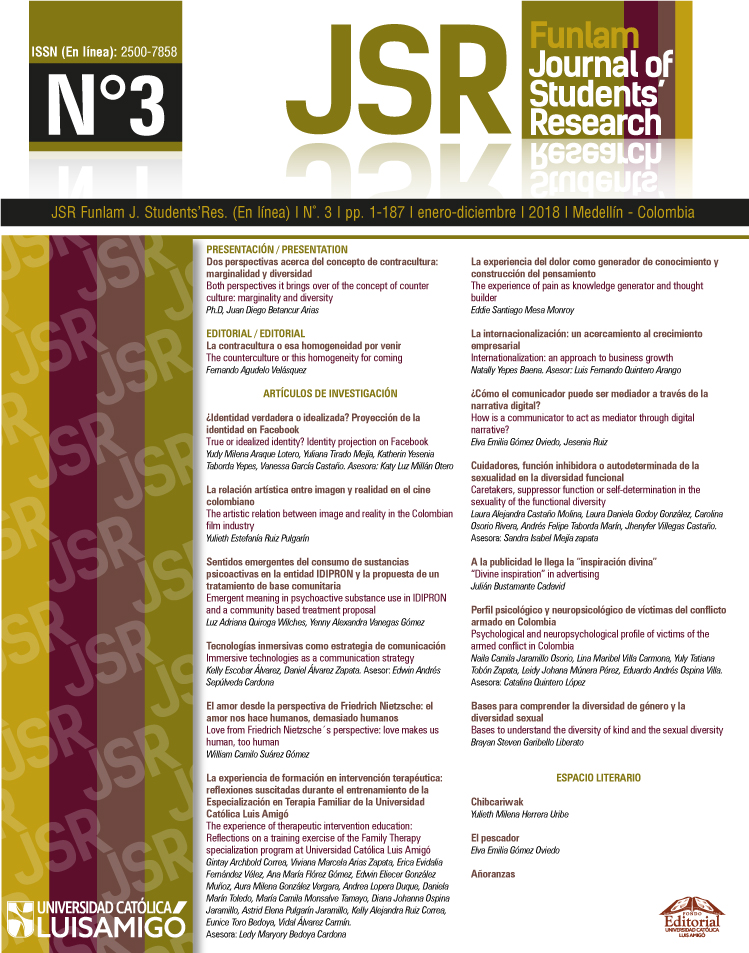Emergent meaning in psychoactive substance use in IDIPRON and a community based treatment proposal
DOI:
https://doi.org/10.21501/25007858.3130Keywords:
drug-dependency, protective factors, risk factors, primary prevention, secondary prevention, tertiary prevention, community based treatment.Abstract
This paper analyzes the use of psychoactive substances as a category in 5 people between 25 and 27 years old, in the “La Rioja” integral protection unit in IDRIPON, in the city of Bogotá. They participated in a semi structured interview, thus, finding answers to some emergent meanings such as supervision negligence, deficiency in their life projects, weak affective relationships, negative peers and acknowledgment of their consumption habits. These emergent meanings made way for conclusions regarding the origin of psychoactive substance use and the current situation of these young adults, such as upbringing, identity development state, family ties and different phases in their addictions. Thus, bringing about the conclusion that, by identifying the risk factors in these emergent meanings, there is an option for a community based treatment, using scientific evidence that can be adjusted to specific situations and the reality by modifying behavioral patterns which clearly determines drug-dependency in each one.Downloads
References
Becoña Iglesias, E. (2002). Bases científicas de la prevención de las drogodependencias. Madrid: Plan Nacional sobre Drogas.
Becoña Iglesias, E. (2007). Bases psicológicas de la prevención del consumo de drogas. Papeles del Psicólogo,28(1), 11-20. Recuperado de http://www.redalyc.org/pdf/778/77828103.pdf
Bordignon, N. A. (2005). El desarrollo psicosocial de Eric Erikson. El diagrama epigenético del adulto. Revista Lasallista de Investigación, 2(2), 50-63. Recuperado dehttp://www.redalyc.org/pdf/695/69520210.pdf
Clayton, R. R. (1992). Transitions in drug use: Risk and protective factors. In M. Glantz & R. Pickens (Eds.),Vulnerability to drug abuse (pp. 15-51). Washington, C.D: American Psychological Association. DOI:http://dx.doi.org/10.1037/10107-001
Milanese, E. (2012). Tratamento comunitário: manual de trabalho I. São Paulo: Secretaria Nacional de Políticasde Drogas, Instituto Empodera.
Millman, R. B., & Botvin, G. J. (1992). Substance use, abuse, and dependence. In M. Levine, N.B. Carey, A. C. Crocker y R. T. Gross (Eds.), Developmental–Behavioral Pediatric (pp. 451-467) (2a. ed.). Nueva Cork: Saunders.
Ministerio de la Protección Social, MSPS. (2007). Política nacional para la reducción de consumo de sustancias psicoactivas y su impacto. Bogotá: Ministerio de la Protección Social.
Ministerio de Salud y Protección social, MSPS. (2012). Caja de herramientas, tratamiento basado en la comunidad. Bogotá: Peñafiel.
Papalia, D., Wendkos Olds, S., y Duskin Feldman, R. (2012). Desarrollo Humano. México: Mc Graw Hill.
Pesca, A. (2016). IDIPRON: Una experiencia pedagógica de la calle. Recuperado de http://www.idep.edu.co/sites/default/files/libros/Una%20experienci%20de%20convivencia%20social.pdf
Prochaska, J., & DiClemente, C. (1984). The transtheoretical approach. New York: Dow Jones.
Valles, M. (2002). Cuadernos metodológicos. Entrevistas cualitativas. España: Centro de Investigaciones Sociológicas.


